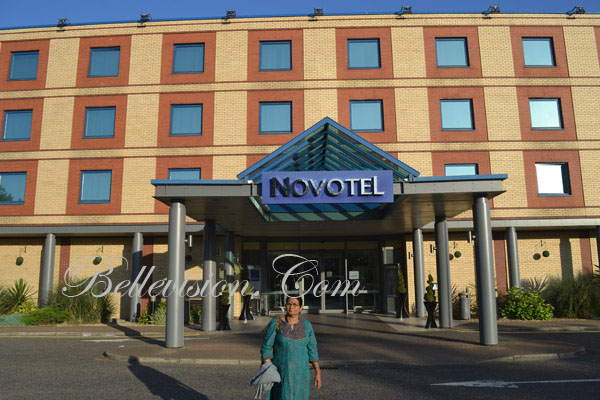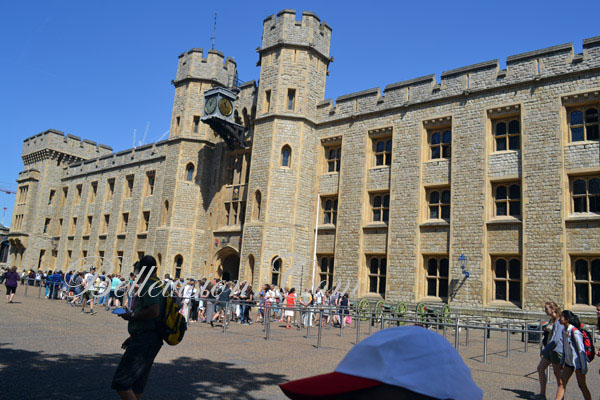Travelogue: ‘Wonders of Europe’ - London in a Day
By Dr Eugene DSouza, Moodubelle
Bellevision Media Network
Udupi, 01 Aug 2013: Having toured some parts of India, especially the Himalayan region, I had been waiting for an opportunity to travel to some of the European countries and see the places and monuments that one normally views in pictures and other media. Being a student and teacher of European History, I used to visualize those aspects which I learnt and taught and dreamt that sometimes in future I would be able to see personally some of those places and monuments associated with the historical past.
This dream of mine became a reality when my colleague and friend in the college and co-traveler within India suggested in last November that we could make a trip to Europe through a reputed travel company-Kesari as some of his acquaintances have had already booked their tour known as “Wonders of Europe” extending for 15 days and covering 10 countries and 25 cities. Sensing an opportunity to realize my dream, I immediately agreed to join him and the group and hence the preparation for the grand European tour began from November 2012.
After completing the visa formalities and making full payment for the tour, 42 tourists assembled at the Mumbai airport at early morning of July 9 to complete the security, immigration and check-in formalities. In this we were guided by Kunal Gorekar, a young Tour Manager who remained with us till the end of the European tour.
Our tour group of 42 comprised of persons from different regions. One family of Indian origin was from Australia, one elderly couple from the US, others from Bangalore, Karwar and Udupi in Karnataka and Dhulia, Karad, New Mumbai, Dombivli and Mumbai in Maharashtra. Most of the tourists were senior citizens but were quite enthusiastic and jovial.
The first leg of our air travel started by the Qatar Airways which took off at 4.40 am to Doha covering the distance in about 3.15 hours. As the aircraft made its approach to the Doha Airport, I was amazed to see the eastern horizon turning yellowish red in anticipation of the sunrise. It was a wonderful sight. As I did not have the camera in the cabin baggage, I used the cell-phone to click few pictures of the colourful sky and few moments later the rising sun and also as the aircraft was approaching the runway the passing settlement below and some of the aircrafts.








As the aircraft halted at the Doha airport, we were transported to the transit lounge and after security check up and other formalities we waited for the second leg of our journey from Doha to London by another aircraft of the same airways which began its flight at 7.55 am and after nearly 7.40 hours reached Heathrow Airport from where we were taken to a hotel after the completion of immigration formalities.
The first day of the tour was just the air-journey. Though it was quite exciting to travel by air, most of the tourists were quite tired and felt the jet lag and took rest.
After sufficient rest all of us were ready for the London tour on a hired bus the next day, 10 July 2013. As we passed through the suburb we could see old peculiar residential areas, a lot of greenery, well laid roads which allowed smooth traffic flow. Though there was some amount of traffic jam at some places, motorists were never seen to be impatient. In fact we never heard the sound of the horn throughout our tour in Europe. Every motorist found to take whatever traffic snarl in the city during peak hours in his stride and behaved in a disciplined manner.













As we entered the city of London, the buildings seemed familiar as the architecture of these buildings somewhat found to be similar to those few colonial buildings still surviving in the Fort area of Mumbai built during the British period. Beautiful flowers could be seen on the bases of the windows as well as adorning the mid-portion of some of the lamp-posts. This sight was common in whichever country we visited in Europe.
A company appointed guide met us near the National Museum who accompanied us throughout that day’s tour. As it was difficult to see the entire city and the important tourist attractions in one day, the guide pointed out important landmarks of London as the bus moved asking us to see to the right or left to look at these important places. In this way we just had the glimpses of the Hyde Park, Piccadilly Circus, the famous Harrods shopping centre and the Sherlock Holms Restaurant.
At the north-east corner of Hyde Park is the Marble Arch. It was originally built in 1827 as a gateway to Buckingham Palace, but it was moved to its present location in 1851. The design by John Nash was based on the Arch of Constantine in Rome.
The origin of the name ‘Piccadilly’ can be traced to seventeenth century frilled collar named Piccadil. Roger Baker, a tailor who became rich making Piccadils lived in the area. The word ‘Circus’ refers to the roundabout around which the traffic circulated. Piccadilly Circus is now partly pedestrianized and is a favourite place for people to meet before going to the nearby shopping and entertainment areas such as Soho, Chinatown, Leicester Square and Trafalgar Square.
Next, we halted at the Trafalgar Square for a closer look at the monument that commemorates the glorious naval victory of the British under the leadership of Admiral Nelson over Napoleon’s French fleet in the Battle of Trafalgar in 1805. Trafalgar Square, the largest square in London, is often considered the heart of London. Ever since the Middle Ages, Trafalgar Square has been a central meeting place. At the middle of the square stands a tall column, a monument honoring Admiral Nelson who laid down his life in this battle. The column is guarded by four lion statues at its base. There are a number of statues and sculptures in the square, with one plinth displaying changing pieces of contemporary art. The square is also used for political demonstrations and community gatherings, such as the celebration of New Year’s Eve.







After spending few minutes at the Trafalgar Square we headed to the first of the major tourist attractions of London, the Tower of London Museum close to which is located the famous London Bridge.
The Tower of London, is a historic castle on the north bank of the River Thames in Central London. It was founded towards the end of 1066 as part of the Norman Conquest of England. The White Tower, which gives the entire castle its name, was built by William the Conqueror in 1078, and was a resented symbol of oppression, inflicted upon London by the new ruling elite. The castle was used as a prison from 1100 until 1952. There were several phases of expansion, mainly under Kings Richard the Lion heart, Henry III, and Edward I in the 12th and 13th centuries.
The Tower of London has played a prominent role in English history. It was besieged several times and controlling it has been important to controlling the country. The Tower has served variously as an armoury, a treasury, a menagerie (collection of wild animals in captivity), the home of the Royal Mint, a public records office, and the home of the Crown Jewels of the United Kingdom for which it is famous now.
The Tower of London has become established as one of the most popular tourist attractions in the country. It has been a tourist attraction since at least the Elizabethan period, when it was one of the sights of London that foreign visitors wrote about. The Crown Jewels attract much interest and the world famous Kohinoor diamond that originated in India can be seen at the centre of one of the royal crowns displayed among the exhibits. Tourists are not allowed to take pictures of the Crown Jewels. Over three million people visit the Tower of London Museum every year.
















London’s Tower Bridge is one of the most recognizable bridges in the world. The Tower Bridge was planned in 1876 when the east of London became extremely crowded and a bridge across the Thames River seemed a necessity. The construction of the bridge started eight years later. The bridge was designed by architect Horace Jones and was eventually completed in 1894. The 265 meter long bridge was constructed with 11,000 tons of steel and was built in the Victorian Gothic design. It is a movable bridge as provision was made for opening of the bridge in the centre to accommodate the boat traffic from the nearby harbor.
Across the Thames River modern buildings could be seen among which the tallest building in Europe, the Shard. The Shard, also referred to as the Shard of Glass, is a 95-storey skyscraper in London with a height of 308 meters and having 72 floors. The architect of the Shard is Renzo Piano. The construction of the building started in 2009 and it was opened to the public since 1 February 2013.
After spending considerable time at the Tower of London and surrounding area, we proceeded to the Buckingham Palace, the official residence of Queen Elizabeth II. On the way the guide pointed out two dragon statues on two sides of the road known as the ‘Dragon Boundary’. The dragon boundary marks are cast iron statues of dragons on metal or stone plinths that mark the boundaries of the City of London. The dragons are painted silver, with details of their wings and tongue painted in red. The dragon stands on its two rear legs, with the right foreleg raised and the left foreleg holding a shield which bears the City of London’s coat of arms, painted in red and white.




We had to walk for some distance in order to reach the amazing complex of the Buckingham Palace. There were many tourists from different parts of the world clicking pictures of the palace and the huge monument known as the Victoria Memorial in front of the main gate. The Victoria Memorial was created by sculptor Sir Thomas Brock in 1911 and erected in front of the main gates at Buckingham Palace to mark the 64 year reign of Queen Victoria.





The origin of the Buckingham Palace can be traced to 1705 when a country house was constructed by the Duke of Buckingham, John Sheffield. King George III bought the house in 1761 for his wife and had it altered. In 1826, King George IV asked the famous architect John Nash to expand the house then known as the Buckingham House into a palace. King George IV as well as his younger brother and successor King William IV both died before the palace was completed. Queen Victoria was the first to reside in the Buckingham Palace.
From the Buckingham Palace we walked back to the bus where it was parked and proceeded to one of the most fascinating tourist attractions in London-Madam Tussaud’s Wax Museum. As we reached the site, the serpentine queue made us to wait for nearly one and a half hour. On entering the museum one could not believe the amount of work that has undergone in creating such wonders in wax medium.
My curiosity about Madam Tussaud prompted me to do some research to understand the person and her work. Marie Tussaud (1761-1850), a native of Strasbourg, France learnt the art of sculpting from her mother’s employer named Philippe Curtius, a physician skilled in wax modeling. Young Marie Tussaud made her first sculpture that of the French Philosopher Voltaire, at the age of 16. Her first solo exhibition on Baker Street was in 1835 followed by her famous Chamber of Horrors collection in 1845.















Following her death in 1850, thirty four years later in 1884, Madam Tussaud’s Wax Museum was shifted to its current location on London’s Marylebone Road where millions have stood in line for hours to get a glimpse of her work and that of her successors.
Madam Tussaud’s Wax Museum houses thousands of replicas of famous people. Visitors can view world leaders, actors and actresses including Bollywood stars Amitabh Bachan, Sharukh Khan, Salman Khan, Rithik Roshan, Madhuri Dixit and Aishwarya Rai, sports legends including Sachin Tendulkar, famous writers and artists, religious leaders, musicians and a number of other characters. As photography is allowed, there is craze among the tourists to pose for pictures by the side of the replica of their favourite personality as the replicas bear a lifelike resemblance to the personalities replicated. Besides these displays there are also several themed sections such as Chamber of Horrors and a taxi ride which takes the tourist on a journey through the history of London. At the end of the journey the tourist can see his or her own picture displayed on the screen.
London Eye which could be seen from different areas of the city of London was the last destination in our tour itinerary of London. Though it was getting late, our tour manager, Kunal managed to get us to the spot before it was too late. As he got the tickets, we stood in the queue waiting for our turn to enter one of the capsules fixed to the giant rim of the London Eye.
London Eye is relatively a recent addition to the tourist attraction of London. It is a giant observation wheel erected in the Jubilee Gardens on the South Bank of the River Thames. The 135 meter tall structure was built as part of London’s Millennium celebrations.
The structure was designed by the group of architects comprising of husband and wife team-David Marks and Julia Barfield and others. The British Airways sponsored the project.




















Construction of the London Eye took nearly one and a half year. Over 1700 tons of steel were used for the structure and more than 3000 tons of concrete were used for the foundations. It was built at a cost of 70 million pounds. The London Eye was opened to the public on 9 March 2000. When erected in 1999 it was the tallest Ferris wheel in the world, until surpassed first by the 160 m (520 ft) Star of Nanchang in 2006 and then the 165 m (541 ft) Singapore Flyer in 2008.
The futuristic looking 32 capsules attached to the rim of the London Eye can each carry 25 passengers making a total of 800 passengers per revolution. The 25 meter long spindle was built in the Czech Republic. The rim has a diameter of 122 meters and 80 spokes connect the rim with the spindle. The complete turn takes about 30 minutes.
It was an exciting moment when we stepped into the capsule. Slowly the capsule moved upwards without even our knowledge. As it rose higher we could see the surrounding monuments dwarfing and gradually the city going underneath enabling us to have a bird’s eye view covering 360 degrees of the city. Many famous landmarks including St. Paul’s Cathedral, Westminster Abbey, Houses of Parliament, the Big Ben and even Buckingham Palace could be viewed from the top of the London Eye.
After alighting from the capsule we rushed to the awaiting bus that took us back to our hotel. Though tired after hectic site seeing, all of us had the satisfaction that major landmarks of London had been covered.
As we reached the hotel, Kunal informed us that the wakeup call for the next day would be at 3 am and at 4 am we would be moving to St. Pancras Railway Station to take the superfast train known as the ‘Eurostar’ to Paris.
 Write Comment |
Write Comment |  E-Mail To a Friend |
E-Mail To a Friend |
 Facebook |
Facebook |
 Twitter |
Twitter |
 Print
Print | Comments on this Article | |
| John, London | Mon, May-18-2015, 5:46 |
| Stunning pics. Love them all. London time and weather is given here along with nearby towns: www.timejones.com/WorldClock/United Kingdom/England/London | |


















